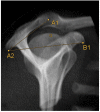Establishing Normative Values for Acromion Anatomy: A Comprehensive MRI-Based Study in a Healthy Population of 996 Participants
- PMID: 38201416
- PMCID: PMC10795676
- DOI: 10.3390/diagnostics14010107
Establishing Normative Values for Acromion Anatomy: A Comprehensive MRI-Based Study in a Healthy Population of 996 Participants
Abstract
Shoulder pain is a common issue often linked to conditions such as subacromial impingement or rotator cuff lesions. The role of the acromion in these symptoms remains a subject of debate. This study aims to establish standardized values for commonly used acromion dimensions based on whole-body MRI scans of a large and healthy population and to investigate potential correlations between acromion shape and influencing factors such as sex, age, BMI, dominant hand, and shoulder pain. The study used whole-body MRI scans from the Study of Health in Pomerania, a German population-based study. Acromion index, acromion tilt, and acromion slope were measured. Interrater variability was tested with two independent, trained viewers on 100 MRI sequences before actual measurements started. Descriptive statistics and logistic regression were used to evaluate the results. We could define reference values based on a shoulder-healthy population for each acromion parameter within the 2.5 to 97.5 percentile. No significant differences were found in acromion slope, tilt, and index between male and female participants. No significant correlations were observed between acromion morphology and anthropometric parameters such as height, weight, or BMI. No significant differences were observed in acromion parameters between dominant and non-dominant hands or stated pain intensity. This study provides valuable reference values for acromion-related parameters, offering insight into the anatomy of a healthy shoulder. The findings indicate no significant differences in acromion morphology based on sex, weight, BMI, or dominant hand. Further research is necessary to ascertain the clinical implications of these reference values. The establishment of standardized reference values opens new possibilities for enhancing clinical decision making regarding surgical interventions, such as acromioplasty.
Keywords: MRI diagnostics; acromion anatomy; acromioplasty; reference values; rotator cuff lesions; shoulder pain; subacromial impingement.
Conflict of interest statement
The authors declare no conflicts of interest. The funders had no role in the design of the study; in the collection, analyses, or interpretation of data; in the writing of the manuscript, or in the decision to publish the results.
Figures














References
-
- Urwin M., Symmons D., Allison T., Bramah T. Estimating the Burden of Musculoskeletal Disorders in the Community: The Comparative Prevalence of Symptoms at Different Anatomical Sites, and the Relation to Social Deprivation. Ann. Rheum. Dis. 1998;57:649–655. doi: 10.1136/ard.57.11.649. - DOI - PMC - PubMed
Grants and funding
LinkOut - more resources
Full Text Sources

